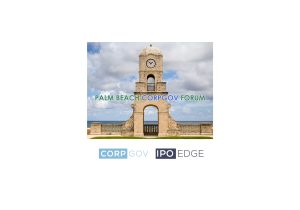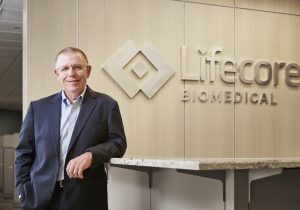
Is it possible for grocers and markets to offer delivery at normal prices to consumers? Unfortunately, razor-thin gross margins along with high costs of additional labor and fleets make it extremely difficult to do so profitably. Even Amazon.com, Inc. appears to offer grocery deliveries at a loss – which is only manageable because it generates profits in other parts of the company. That’s according to Peter van Stolk, CEO of Food-X Technologies, a technology company that helps brick-and-mortar grocers introduce an e-commerce offering and still earn a profit on sales. In an interview with IPO Edge, Mr. van Stolk explains how his model works and why e-commerce can help keep consumers safe during the ongoing coronavirus pandemic.
IPO Edge: Is the coronavirus epidemic keeping shoppers out of supermarkets? Can you share any data on transaction volume to indicate they are ordering for delivery instead?
Mr. van Stolk: It’s important to remember that we are not writing the playbook on consumer behavior with respect to the coronavirus and consumer shopping patterns. Asia and Europe had the pen and in those markets we have seen a huge growth in demand for online grocery. The coronavirus is already changing consumer behavior and that will not stop soon.
In terms of data, we have seen one of our client’s – SPUD.ca – order volume grew by over 350{efe5d79870c08482e17ab0c97855f89429dac5f22c46026d3ca83573faec2208} compared to last year. Across all of our facilities, we are witnessing unprecedented demand for delivery.
Obviously, the pandemic is pushing an enormous amount of grocery business online. In fact, many supermarkets are having a hard time handling the dramatic increase in business.
IPO Edge: Is it truly safe to order from a supermarket that picks up produce from the actual store and delivers it? Or is there a health and safety advantage to a distribution center?
Mr. van Stolk: Supermarket produce is safe; however, we recommend that everyone wash their produce before eating it. A distribution center is a closed environment that is designed to not have customers. There are lots of distinct differences to a distribution center model vs. a supermarket model, which makes the distribution center more efficient and effective thus more profitable.
However, with the situation we are in currently, distribution centers are a closed environment which is perhaps the biggest, most important difference. It is not open to the public, it’s a controlled environment for the food and the workers, and protective gear is mandated.

IPO Edge: Is it possible for an individual grocer or market to offer in-store prices for delivery with its own fleet and drivers? Please explain the challenge of delivery in an industry with thin margins.
Mr. van Stolk: Yes it’s possible. But is it profitable? The grocery model was based on the consumer utilizing their time and vehicle to drive and shop in a grocery store, and the grocer would offer low prices to keep the model working. Online grocery is breaking that model for the grocer because now the grocer is responsible for costs that were not built into their model, (pick-pack costs, delivery costs, e-commerce costs, e-commerce customer care costs).
Now grocers are stuck because they cannot raise product prices due to the competitive market, but they can charge an offsetting cost for delivery. So the delivery fee subsidizes a portion of the costs for the grocer. The challenge is that consumers will only pay $10.00 delivery fee for grocery and that does not cover the costs for a grocer to own its own fleet.
The next challenge for the grocer is the “Amazon effect” which is that Amazon drives the delivery fee down (via Prime) and offsets those costs with AWS and other services. Grocers do not have those offsetting revenues to compete so they must operate a profitable e-commerce business model. Food-X technology provides them with profitable unit economics.
IPO Edge: Historically grocery ecommerce delivery is not profitable – what makes Food-X different?
Mr. van Stolk: Historically, grocers and retailers have attempted to use their stores as fulfillment centers, but it’s just not economical. We take a different approach in which we use all assets – vehicles, routing, bin management, delivery, warehouse and inventory management and labor – on every order. All of which allows us to deliver unit economics that are profitable.
IPO Edge: When you approach a new partner, how do you frame e-commerce? Can you compare it to a new store?
Mr. van Stolk: Yes, our retail partners often like to think of it like a new store on a relative basis. The difference with Food-X is our capabilities allow retailers to do three times the gross merchandise volume (GMV) with the same capital expenditure.
And we have been doing fresh delivery for decades. And we know how to manage a wide geography. Even for small operations, which is what SPUD was when we got started.
IPO Edge: In the United Kingdom, Ocado Group plc has been a pioneer in grocery delivery but the country is much smaller than the U.S. Can you really deliver across the country even in sparsely-populated places?
Mr. van Stolk: Yes, absolutely. We have built tremendous flexibility into our model and can service small and midsize towns and cities, as well as huge ones with high population density – and those at a distance.
We can do it based on our scalability, and the network we establish between smaller fulfillment centers and larger ones, as well as grocers’ existing assets.
Peter van Stolk is the Founder and CEO of Food-X Technologies, the only scalable end-to-end software solution for the eGrocery market. Prior to founding Food-X, Peter has been a member of the Board of Directors for both healthy beverage company Steaz, and Kor Water.
As founder of Jones Soda Company in 1987, Mr. van Stolk served as CEO and Chairman of the Board of Directors through 2007. He also sits on the Board of Directors for Vitamin Angels, a charity for children that seeks to provide vital nutrition to children.
With an intense connection to his consumers and an uncanny ability to predict trends, Mr. van Stolk is passionate about improving sustainability through the integration of eGrocery, and improving the grocery industry as a whole. He has been recognized for his business savvy and innovative branding strategies in various publications such as The New York Times, CNN, Wall Street Journal, Fast Company, Inc. Magazine and People Magazine. Peter van Stolk has received numerous business awards including PriceaterhouseCoopers’ 40 under 40, Brand Week’s Top 100 Marketer, and was chosen as one of Canada’s Top One Hundred Canadians by MacLean’s Magazine.






